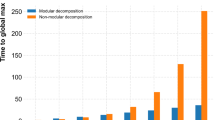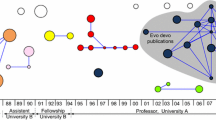Abstract
The question of the division of cognitive labor (DCL) has given rise to various models characterizing the way scientists should distribute their efforts. These models often consider the scientific community as a self-governed sphere constituted by rational agents making choices on the basis of fixed rules. Such models have recently been criticized for not taking into account the real mechanisms of science funding. Hence, the question of the utility of the DCL models in guiding science policy remains an open one. In this paper, we show that two unconsidered dimensions would have to be taken into account. First, DCL studies miss the existence of distinct levels of epistemic objectives organizing the research process. Indeed, the scientific field is structured as a system of hierarchical, interconnected practices which are defined both by their inherent purposes and by various superposed external functions. Second, I criticize the absence of ontological considerations, since the epistemological significance of pluralism is highly dependent on the nature of the object under study. Because of these missing dimensions, current DCL models might have a limited usefulness to identify good practices of research governance.
Similar content being viewed by others
Notes
See, for instance, Wilholt and Glimell (2011) for a synthetic historical panorama.
Of course, the question of the governance of science is not limited to that of the processes of grant allocation by funding agencies. Our paper exclusively deals with epistemic considerations, but ethics and political philosophy also have their say. The so-called “responsibility” of research and innovation (Arip 2016), and the democratic involvement of citizens in science policy decisions (Kitcher 2001) constitute central perspectives on this matter.
Devoted to the “assessment of the epistemic consequences of adopting certain institutional arrangements or systemic relations as opposed to alternatives”.
Some instances of this interpretative prudency, among others: “Can our models fix useful concepts and provide templates for causal mechanisms that could be at play? Could they be used to help shape the debate around emerging policy decisions? The answers will come from future work in the field” (Avin 2018b, p.32); “The cautious conclusion to be drawn from these differences is that, in its entirety, the relationship between diversity and epistemic performance is likely to be more complex than can be captured by any simple model” (Pöyhönen 2016, p. 4530); “Of course these models are limited in two critical ways. First, they proceed into idealizations about the structure of the scientific community and about individual scientists. Real scientists and scientific communities are more complicated than our models, and it is always possible that a critical causal factor has been left out” (Zollman 2018, p. 26).
Let us maintain, following Kelly (2003), that instrumental rationality classically designates “the rationality which one displays in taking the means to one’s ends” (p. 612)”. It is opposed to epistemic rationality, defined as “the kind of rationality which ones displays when one believes propositions that are strongly supported by one’s evidence and refrains from believing propositions that are improbable given one’s evidence”. In DCL models, as noted by Zollman (2018), epistemic rationality is understood as a form of instrumental rationality: “epistemic rationality is a species of instrumental rationality, viz. instrumental rationality in the service of one’s cognitive or epistemic goals” (Kelly (2003), p. 613). In other words, epistemic rationality is expected to be mobilized to choose the best alternative (the Mi which has the estimated highest probability to reach O) to solve a cognitive or epistemic problem. This instrumentalist conception of epistemic rationality corresponds to the multiplicity of the (cognitive, practical, utilitarian) kinds of objectives considered in the DCL models.
The opposition between “epistemic” and “non-epistemic” factors may be discussed, since the objective of DCL models is precisely to show that “non –epistemic” factors positively influence the search for truth. However, the rationale behind this distinction lies on a contrast between the motivations guiding the choices made by researchers, as well exposed in Zollman (2018). If these motivations are exclusively those of solving the problems posed to the community, they are considered as acting as purely epistemic agents –even if this problem is not itself strictly cognitive.
For a graphical representation of this hierarchical imbrication of activities, see the “commentary” on Chang’s work by L. Soler and R. Catinaud in Soler et al. (2014).
This exhaustive examination may be completed, in the spirit of Kitcher (2001), by a democratic assessment of the various desires expressed by ordinary citizens.
We may also imagine here that publics which are exterior to the scientific field (citizens, economic sphere or political actors) could also have their say in this process of proposing and voting for projects.
If we follow the examples provided by the authors, these objectives may be to cure peptic ulcer, to make astronomical predictions of the “locations of heavenly bodies” in 1550 (by choosing between Ptolemaic or Copernican paradigms, p. 1063) etc.
References
Adam, M. (2005). Integrating research and development: The emergence of rational drug design in the pharmaceutical industry. Studies in History and Philosophy of Biological and Biomedical Sciences, 36, 513–537.
Arip, A. (2016). The clothes of the emperor. An essay on RRI in and around Brussels. The Journal of Responsible Innovation, 3(3), 290–304.
Avin, S. (2018a). Policy considerations for random allocations of research funds. Roar Transactions, 6(1).
Avin, S. (2018b). Centralized fundings and epistemic exploration. The British Journal for the Philosophy of Science. https://doi.org/10.1093/bjps/axx059.
Boudreau, K. J., Guinan, E. C., Lakhani, K. R., & Riedl, C. (2016). Looking across and looking beyond the knowledge frontier: Intellectual distance, novelty, and resource allocation in science. Management Science, 62(10), 2765–2783.
Chang, H. (2014). Epistemic activities and Systems of Practice: Units of analysis. In L. Soler, S. Zwart, M. Lynch, & V. Israel-Jost (Eds.), Philosophy of science after the practice turn. New York: Routledge.
De Langhe, R. (2014). A unified model of the division of cognitive labor. Philosophy of Science, 81, 444–459.
Fang, F.-C., & Casadevall, A. (2016). Research funding: The case for a modified lottery. mBio, 7(2), e00422–e00416.
Gillies, D. (2014). Selecting applications for funding. Why random choice is better than peer-review. RT. A Journal on Research Policy and Evaluation, 2(1). https://riviste.unimi.it/index.php/roars/article/view/3834. Accessed 24 Sept 2018.
Goldman, A., & Blanchard, T. (2016). Social epistemology. In E. N. Zalta (Ed.), The Stanford encyclopedia of philosophy, winter 2016 edition. https://plato.stanford.edu/entries/epistemology-social/. Accessed 24 Sept 2018.
Graves, N., Barnett, A. G., & Clarke, P. (2011). Funding grant proposals for scientific research: Retrospective analysis of scores by members of grant review panel. BMJ, 343, d4797.
Hacking, I. (1983). Representing and intervening. Cambridge: Cambridge University Press.
Haufe, C. (2013). Why do funding agencies favor hypothesis testing? Studies in History and Philosophy of Science, 44, 363–374.
Kelly, T. (2003). Epistemic rationality as instrumental rationality: A critique. Philosophy and Phenomenological Research, 66(3), 612–640.
Kitcher, P. (1990). The division of cognitive labor. The Journal of Philosophy, 87(1), 5–22.
Kitcher, P. (1993). The advancement of science. New York: Oxford University Press.
Kitcher, P. (2001). Science, truth and democracy. New York: Oxford University Press.
Kummerfeld, E., & Zollman, K.-J.-S. (2016). Conservatisme and the scientific state of nature. The British Journal for the Philosophy of Science, 67(4), 1057–1076.
Longino, H. (2013). Studying human behavior: How scientists investigate aggression and sexuality. Chicago: The Unversity of Chicago Press.
Malaterre, C. (2007). Organicism and reductionism in cancer research: Towards a systemic approach. International Studies in the Philosophy of Science, 21(1), 57–73.
McKenzie, J., & Himmelreich, A.-J. (2015). Epistemic landscapes, optimal search, and the division of cognitive labor. Philosophy of Science, 82, 424–453.
Mitchell, S. (2009). Unsimple truths: Science, complexity, and policy. Chicago: The Unversity of Chicago Press.
Muldoon, R. (2013). Diversity and the division of cognitive labor. Philosophy Compass, 8(2), 117–125.
Muldoon, R., & Weisberg, M. (2011). Robustness and idealization in models of cognitive labor. Synthese, 183(2), 161–174.
Polanyi, M. (1962). The republic of science: Its political and economic theory. Minerva, 1, 54–74.
Pöyhönen, S. (2016). Value of cognitive diversity in science. Synthese, 194(11), 4519–4540.
Ruphy, S. (2005). Why metaphysical abstinence should prevail in the debate on reductionism. International Studies in the Philosophy of Science, 19(2), 105–121.
Soler, L., Zwart, S., Lynch, M., & Israel-Jost, V. (2014). Science after the practice turn in the philosophy, history, and social studies of science. New York: Routledge.
Soto, A. M., & Sonnenschein, C. (2011). The tissue organization field theory of cancer: A testable replacement for the somatic mutation theory. BioEssays, 33(5), 332–340.
Strevens, M. (2003). The rule of the priority rule in science. The Journal of Philosophy, 100, 55–79.
Strevens, M. (2013). Herding and the quest for credit. Journal of Economic Methodology, 20(1), 19–34.
Vaesen, K., & Katzav, J. (2017). How much each researcher receive if competitive government research funding were distributed equally among researchers? PLoS One, 2(9), e0183967.
Viola, M. (2015). Some remarks on the division of cognitive labor. Roar Transactions., 1, 1–14.
Viola, M. (2018). Social epistemology at works: From philosophical theory to policy advice. Roar Transactions, 6(1). https://riviste.unimi.it/index.php/roars/article/view/9828. Accessed 24 Sept 2018.
Weisberg, M., & Muldoon, R. (2009). Epistemic landscapes and the division of cognitive labor. Philosophy of Science, 76(2), 225–252.
Wilholt, T. & Glimell, H. (2011). Conditions of science: The three-way tension of freedom, accountability and utility. In M. Carrier, & A. Norman (Eds.), Science in the context of application. Boston studies in the philosophy of science (Vol. 274, pp. 351–370). Berlin: Springer.
Woody, A.-I. (2014). Chemistry’s periodic law: Rethinking representation and explanation after the turn to practice. In L. Soler, S. Zwart, M. Lynch, & V. Israel-Jost (Eds.), Science after the practice turn in the philosophy, history, and social studies of science. New York: Routledge.
Wray, K.-B. (2000). Invisible hands and the success of science. Philosophy of Science, 67(1), 163–175.
Ylikoski, P., & Aydinonat, N.-E. (2014). Understanding with theoretical models. Journal of Economic Methodology, 21(1), 19–36.
Zollman, K.-J.-S. (2010). The epistemic benefit of transient diversity. Erkenntnis, 72, 17–35.
Zollman, K.-J.-S. (2018). The credit economy and the economic rationality of science. The Journal of Philosophy, 115(1), 5–33.
Author information
Authors and Affiliations
Corresponding author
Additional information
This article belongs to the Topical Collection: EPSA17: Selected papers from the biannual conference in Exeter
Guest Editors: Thomas Reydon, David Teira, Adam Toon
Rights and permissions
About this article
Cite this article
Bedessem, B. The division of cognitive labor: two missing dimensions of the debate. Euro Jnl Phil Sci 9, 3 (2019). https://doi.org/10.1007/s13194-018-0230-8
Received:
Accepted:
Published:
DOI: https://doi.org/10.1007/s13194-018-0230-8




